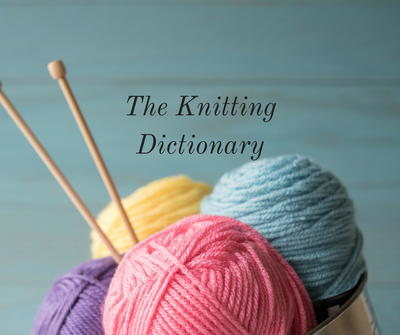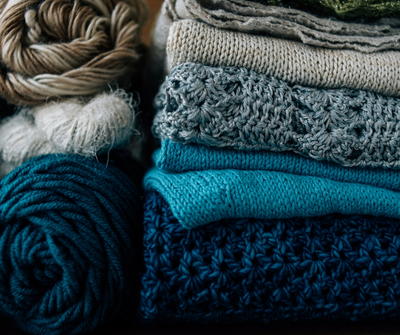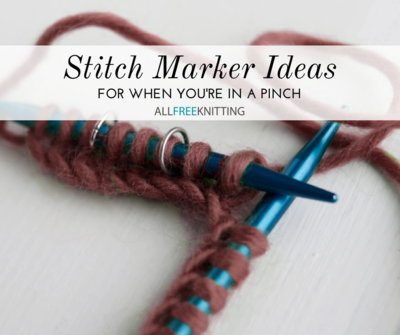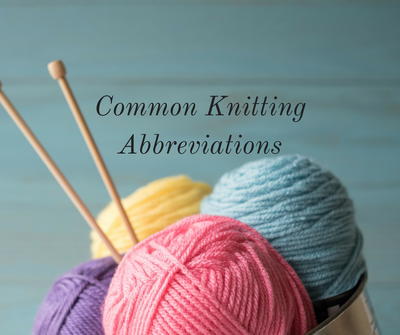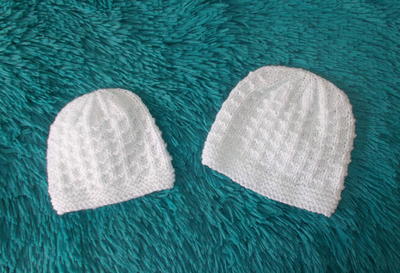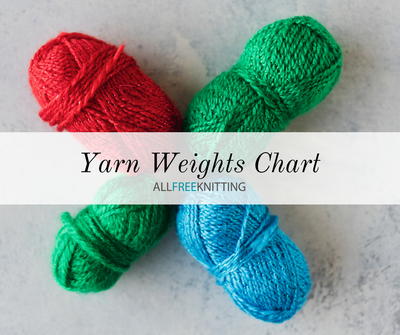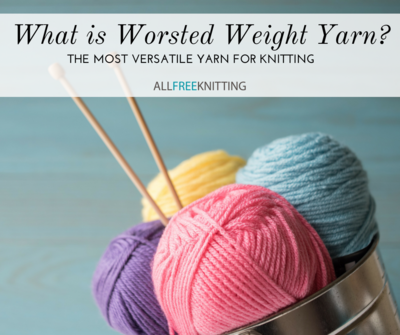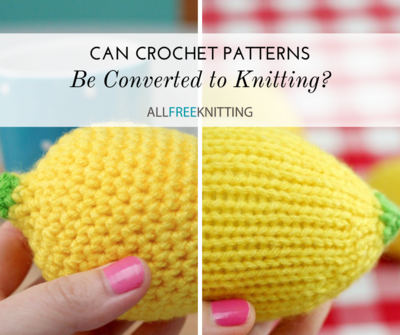The Knitting Dictionary
Ease into the world of knitting with this guide to basic knitting slang and terminology!
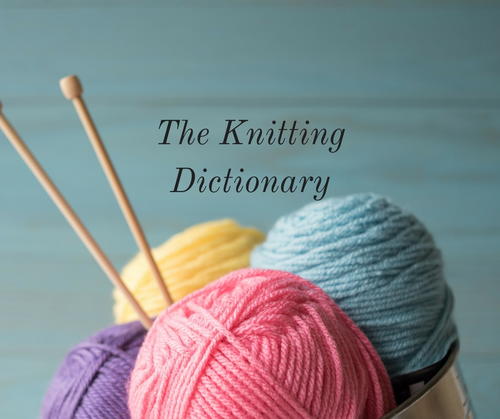
Learning knitting is so much more than just learning a new skill. You practically have to learn a new language! And between the countless abbreviations, bizarre slang, and unfamiliar terms, it can seem like a daunting process for knitting newbies!
We took to the AllFreeKnitting Facebook page to ask our experienced readers what terms they think all knitters should know! Below are what these knitting experts say are the most important knitting terms that all knitters should know.
We have also made a handy chart of the most common knitting abbreviations and their meanings that you can download and print. Keep it around for when you come across those goofy abbreviations that you've never seen before.
For more great projects like this, subscribe to our free email newsletter!
Abbreviations and Symbols
| Abbreviation | Definition |
| CO | Cast on |
| K | Knit |
| K2tog | Knit 2 together |
| Kwise | Knitwise |
| M1 | Make 1 |
| P | Purl |
| P2tog | Purl 2 together |
| Pwise | Purlwise |
| Rep | Repeat |
| Sl | Slip |
| Tbl | Through back loop |
| Wyib | With yarn in back |
| Wyif | With yarn in front |
| Yo Yfwd (UK) |
A
Alternate: A term used in knitting patterns that typically refers to an action that is performed every other row. For example, in stockinette, you would alternate between knitting and purling each row. Another use of this term is in decreasing; a pattern might tell you to decrease on alternate rows, meaning you should decrease an even amount every other row.
Aran:
Yarn - A weight classification of yarn that is common in the UK. This weight is similar (but slightly heavier than) worsted weight yarn.
Cable Style - A style of knitting cabling (typically in Aran sweaters) that involves combining different "panels" of cable patterns in the overall design of the garment. This style is named after the Aran islands in Ireland.
Armenian Knitting: A method of tacking floats in stranded knitting. This is done to prevent floats on the wrong side of your work that are too long and make the garment unwearable.
Arm Knitting: Arm knitting is a technique where the knitter uses their arms in place of knitting needles. This is best done with very bulky yarns and with larger projects, like blankets. - Learn More
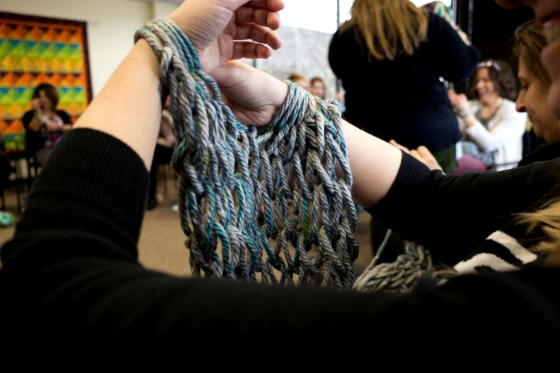
B
Back of Loop: Working a stitch through the back of the loop refers to knitting or purling through the portion of the stitch that's "behind" the needle, relative to you. Doing this will twist the stitch, which is often intentional in certain patterns.
Backstitch: Backstitch is a method of seaming knitting that doubles back on itself to strengthen the seam. - Learn More
Bias: Bias knitting is a type of knitting wherein the columns of stitches are skewed diagonally by increasing on one side of the fabric and decreasing on the other.
Bind Off (Cast Off): These terms simply mean ending a row (or wale) of stitches. In the UK, this is called casting off. There are different binding off techniques, but the most common, simple bind off involves knitting two stitches and passing the first stitch over the second and off the needle. - Learn More
Block (Blocking): An essential part of the knitting process for more complex garments, blocking is a term that refers to any method of "setting" the stitches and the gauge of the garment. There are several ways to do this, but the most popular methods include wet blocking and steam blocking. - Learn More
Bobble: Bobbles in knitting are a form of decorative stitch, often used in lace knitting, created by knitting through the same stitch multiple times. - Learn More
Brioche: Brioche knitting is a knitting technique that creates rib stitch that's formed with a combination of brioche knit stitches and SL1YOs. Doing this will give you a very fluffy and squishy ribbed fabric that feels fluffy like brioche bread, which is where this stitch gets its name! Two-color brioche is far more common than single-color because of the endless, reversible colorwork opportunities with just a few increases and decreases. - Learn More
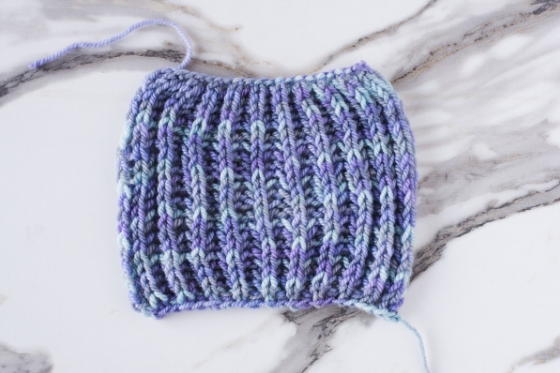
C
Cable Needle (cn): Cable needles are special types of needles used in knitting to hold live stitches off the needles during the cable knitting process. This essentially will allow you to knit your stitches in a different order, creating the cables themselves. Many knitters use DPNs (double pointed needles) for this.
Circular Knitting Needles: Circular knitting needles are a type of knitting needle where two separate needles are attached with a cord. This allows you to knit larger pieces in the round without using DPNs as well as to knit larger flat items that are too wide for regular, straight needles. - Learn More
Combination Knitting (Method): Combination knitting is a method that combines aspects of both Eastern and Western knitting methods. There are many things that make this method unique, but the most prominent one is that knit stitches are worked through the back loop and purl stitches are worked through the front loop; as such, the leading and lagging legs are not uniformly placed on the needles, like in Eastern and Western knitting. - Learn More
| Western | Eastern | Combination | |
| Knit Stitches | Leading leg in front | Leading leg in back | Leading leg in front |
| Purl Stitches | Leading leg in front | Leading leg in back | Leading leg in back |
| Yarn Wrap | Counter-clockwise (for right-handed) |
Clockwise (for right-handed) |
Counter-clockwise for knit (right-handed) Clockwise for purl (right-handed) |
| Stitches | Worked through front loop | Worked through back loop | Worked through back loop for knits Worked through front loop for purls |
| Twisted Stitches | Worked through back loop | Worked through front loop | Worked through front loop for knits Worked through back loop for purls |
Condo Knitting:Condo knitting is a technique of knitting with two different sized knitting needles. Popular in the 1970s, condo knitting creates large gaps in your work, similar to a drop stitch. The smaller needle should match the size of yarn that you are using, and the bigger needle should be drastically larger than that; the larger your second needle is, the more pronounced your condo knit holes will be. - Learn More
Continental Knitting (Picking): A style of knitting that involves holding the working yarn in your non-dominant hand. This allows you to hold the tension in your yarn in a different hand than the one that's actually maneuvering the working needle. Many knitters find this an easier and faster way of knitting. - Learn More
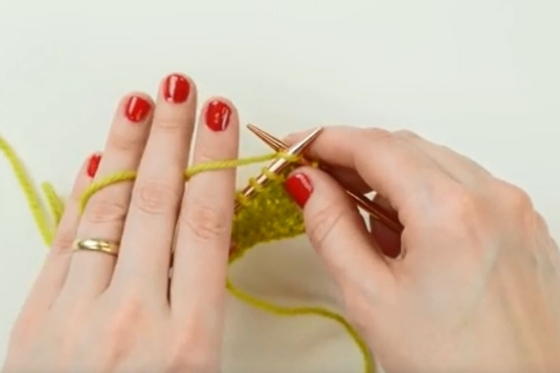
D
Decrease: A decrease is any method of knitting that will lower the number of stitches in a row. There are several ways to do this in knitting, but the most popular are the k2tog and ssk decreases. - Learn More
DK: DK (or double knit) yarn is one of the most popular weight of yarn for knitters. This weight of yarn is typically categorized as a weight 3 yarn, and it's great for things like socks, scarves, and sweaters.
Double Knitting: A knitting technique that gives you two distinct sides to an object, usually a scarf, making it reversible.
Double Pointed Needle (DPN): Double pointed needles are a type of knitting needle that has points on both ends. These are used to knit items in the round that are too small for circular needles. - Learn More
Dropped Stitches:
Dropped Stitches (Mistake) - The first kind of dropped stitches are stitches that have fallen off of the needle during the knitting process. This very common knitting mistake is (thankfully) very easy to fix! Check out our complete guide to fixing knitting mistakes to learn how to fix dropped stitches. - Learn More
Drop Stitch (Stitch Pattern) - The second kind of dropped stitches are stitches that are intentionally dropped to create a loopy lace-style fabric. - Learn More
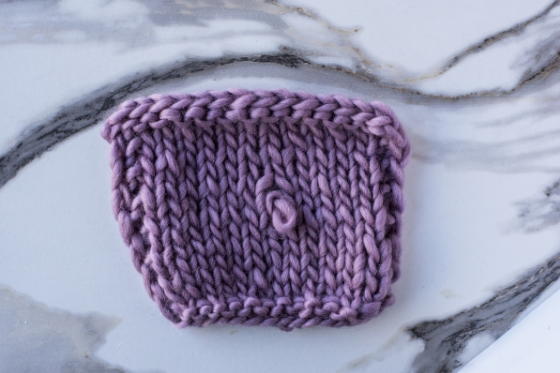
E
Eastern Knitting (Method): Eastern knitting is a method of knitting that puts the leading leg in the back of the work for knit and purl stitches and works all stitches through the back of the loop. For more information on this method, look for the entry on Combination knitting.
English Knitting (Throwing): This style of knitting involves holding the yarn in the dominant hand. Because this style uses the same hand for holding tension and working the yarn, speed and gauge are often slightly different for knitters who use this style. While it is common in the British Isles and North America, English knitting is practiced by knitters all over the world and is probably the most common. - Learn More
Entrelac: Entrelac knitting is a method of knitting that makes a textured diamond design that sort of resembles plaid, using rows of alternating rectangles that build on top of one another. This method looks like strips of knit fabric that are woven together, but it is really one continuous piece of knitting! - Learn More
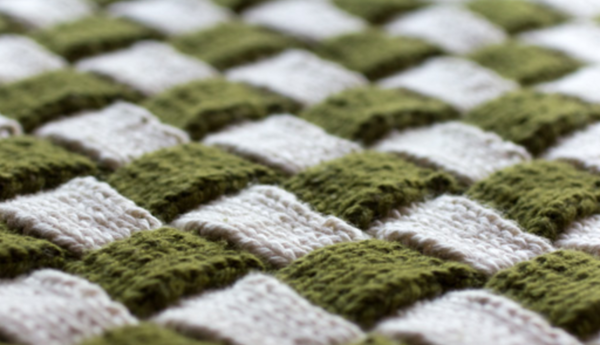
Extreme Knitting: A trend in knitting that focused on extra large needles and extra large yarn (usually roving). This style is great for working projects really quickly, although the cost of new materials and large yarn is typically higher than for regular knitting projects - Learn More
F
Fair Isle: A type of stranded colorwork from Shetland that is characterized by geometric designs called "peeries" as well as common OXO shapes. Fair isle knitting differs from other regional styles of stranded knitting in that it only uses two strands of yarn per row or round, and very rarely will you find a strand of more than five stitches. - Learn More
Finger Knitting: A method of knitting that uses your fingers to work the stitches instead of needles. - Learn More
FO (Finished Object): Finished object (a more general term than, "finished garment" since the object might be knitted amigurumi, home decor, etc.)
Frog: Frogging is a method of undoing stitches by ripping them out and continuing from a previous row. Often this is done with a lifeline in place to prevent frogging past the desired point. - Learn More
G
Garter Stitch: Typically the first stitch that beginner knitters learn, garter stitch is formed when both wrong and right side rows are knitted. - Learn More
Gauge (Tension): Gauge and tension are terms that refer to the number of stitches per inch. Things like the type of yarn, needle size, and stitch pattern can affect gauge. In general, the bigger the yarn is and the bigger the needles are, the less "tense" your stitches will be, giving you larger, looser stitches. This will affect the size of the pattern, so pay close attention to the gauge when knitting things like sweaters, scarves, and cowls. - Learn More
H
Heel Stitch (Eye of Partridge): Heel stitch, often called the Eye of Partridge, is the perfect knit stitch for durable fabric that can take wear and tear. Alternating slipped stitches in this pattern create an extra dense fabric that is often used in the heels of socks. - Learn More
Helix Knitting:Helix knitting is a circular knitting technique that is used to avoid jogs that appear when knitting in the round. This technique uses DPNs and different colors of yarn that start in different places in the same row to create an upward spiral effect in your work, giving you beautiful, seamless stripes!
I
Illusion Knitting: This very impressive knitting technique uses stripes of color and strategically placed purl bumps to create a pattern that only reveals itself when seen from an angle.
Increase: Increases in knitting are special stitches and stitch modifications that allow you to increase the number of stitches in a row. Increases can be single or double increases and most of the time lean either left or right, although it should be noted that some double increases have no lean at all. - Learn More
Intarsia: Intarsia is a method of colorwork knitting that creates blocks of color without strands hanging in the back. Intarsia cannot be knit in the round. - Learn More
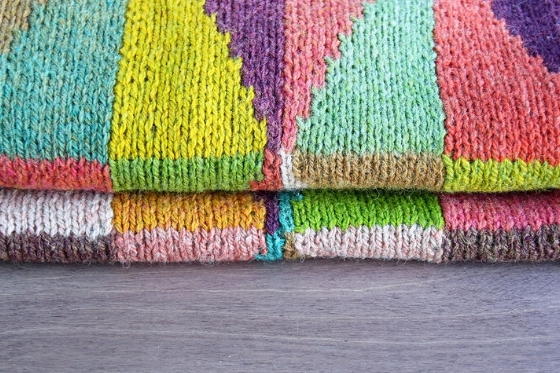
J
Jog: Distortion around different colored sections of knitting, most usually seen knitting stripes in the round.
Join: Joins are any method of combining the two ends of a pattern that is knit in the round. One of the most common joins is the invisible join, which is made by adding one extra stitch to the cast on row and then passing that extra stitch over the first stitch in the pattern to complete the circle. - Learn More
K
KAL (Knit-A-Long): A series of videos used to walk viewers through a particular pattern, step-by-step. Many knit-a-longs will keep the pattern a mystery until the end. Others are used to teach beginners the necessary techniques for knitting a particular type of garment.
KIP or kipping: Knitting in public.
Kitchener Stitch: A method of seaming used to join two pieces of knitting together or to join to ends of the same piece of fabric. This seaming method is often used with stockinette stitch. - Learn More
Knitwise (As If to Knit):Often used when talking about slipped stitches or when giving detailed instructions on a particular increase or decrease, this term refers to inserting your working needle in a way that puts the leading leg of your yarn on the right-hand side of your needle.
Knooking: Knooking is a style of knitting that uses a crochet hook with an eyelet to attach a cord (also called a knook). The cord at the end of the hook acts like your second needle, holding the live stitches in place while you knook the next row with the crochet hook. - Learn More
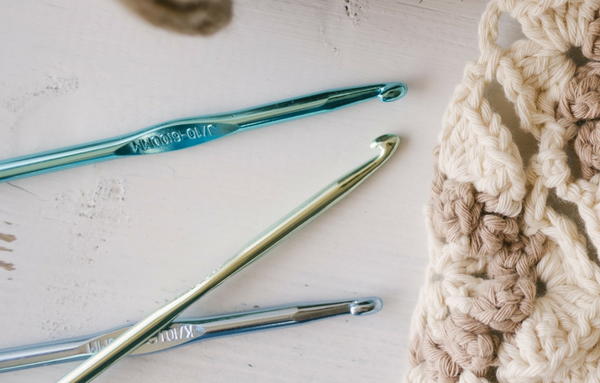
L
Ladder: A gap in knitting that appears between vertical columns of stitches. These usually appear in the round and usually caused by uneven tension.
Lagging Leg: The piece of yarn in a particular stitch that is on the opposite side of the needle from the leading leg (further away from the working yarn and skein).
Leading Leg: The piece of yarn in a particular stitch that is directly attached to the working yarn and skein. You can easily find your leading leg by lightly tugging on the working yarn; your leading leg will move slightly.
Lever Knitting (Flicking): Lever knitting a knitting style in which the knitter holds the working yarn in the dominant hand and loops the yarn around the working needle without removing the dominant hand from the needle completely, creating a sort of back-and-forth levering motion. - Learn More
Lifeline: A piece of yarn or string that is inserted into a previous row to hold those stitches in place in the event that you need to frog your work because of a mistake. They are truly lifesavers.
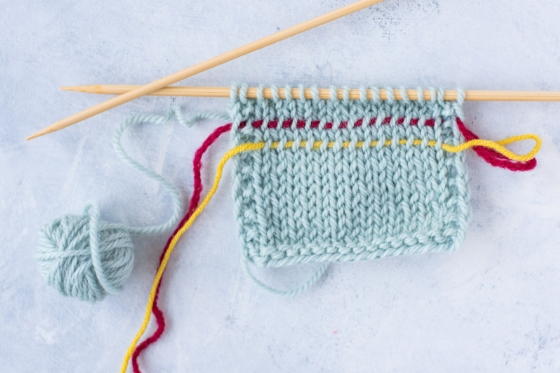
Linen Stitch: Linen stitch is a great stitch pattern that involves slipping stitches with the working yarn held on the right side of the work. This creates a sort of bumped woven pattern that resembles linen fabric. - Learn More
Live Stitch:A term used to refer to unworked stitches that are still on the needle.
Longtail Cast-On: The longtail cast-on is possibly the most common method of casting on stitches. Most beginner knitters will learn to this cast-on method because of its simplicity, speed, and clean finish on most projects. - Learn More
Lopapeysa: A style of stranded colorwork that is native to Iceland. Unlike other stranded styles, like Fair Isle, Lopapeysa often uses three or more strands of yarn per row, making it particularly tricky to master but will give you exceptionally colorful patterns with bold lines and shapes. Colorwork motifs in Lopapeysa often include geometric designs and snowflake-like motifs. Traditional Icelandic knit sweaters typically use Lopapeysa style colorwork for the yoke of the sweater.
M
Magic Loop: The magic loop method is a clever method of knitting in the round for those of you who don't like DPNs. This ingenious technique uses circular needles in a way that lets you knit the super tiny tubes for things like mittens, socks, and gloves. - Learn More
Mattress Stitch: The mattress stitch is a remarkably easy seaming stitch that will result in an invisible seam if done correctly. There are many different seaming methods in knitting, but the mattress stitch is by far one of the most popular because it's truly invisible from the right side of your pattern. - Learn More
Modular Knitting: Also called domino knitting or number knitting, this clever knitting style uses various styles of knitted "modules" to create larger finished projects. Typically, this is a mitered square, but there are other styles of modules as well. - Learn More
Mosaic Knitting: Mosaic knitting refers to a style of knitted colorwork that involves slipping stitches from previous rows; because of this, it's often called "slip stitch knitting" or "slip stitch colorwork." The angular, interlocking colorwork patterns this method creates are incredibly easy to knit and are perfect for beginners who want to try colorwork for the first time. - Learn More

Moss Stitch: Similar to seed stitch, moss stitch is a great knitting stitch for beginners to learn that has some amazing texture to it. This stitch is also sometimes called "double seed stitch." - Learn More
N
Negative Ease: A term used in knitting fitted garments (often sweaters) that refers to either a particular gauge used or additional stitches added to make the garment righter than the exact measurements.
Niddy Noddy: A twisted H-shaped tool that allows you to easily wind up skeins. - Learn More
O
Openwork: A term used in lace knitting to refer to sections or panels of knitting with intricate and decorative holes, often from yarn overs.
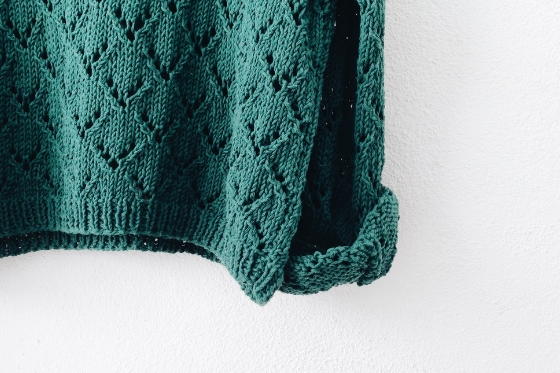
P
Pass Slipped Stitch Over: This is a method of decreasing stitches that is often used in binding off. - Learn More
Plaited Stitch: A kind of stitch that is twisted. Knitting into the back loop will create a clockwise plaited stitch, and twisting the stitch (intentionally or otherwise) will create a counterclockwise plaited stitch. Knitting into the back loop of a stitch is a common method of untwisting accidentally twisted stitches from previous rows.
Plarn: Yarn made from upcycled plastic that is often used to make things like grocery bags and scrubbies. - Learn More
Pom-Pom: Pom-poms are little balls of yarn or fur (often fake) that are used in knitting for things like topping hats or at the ends of tassels and iCords. - Learn More
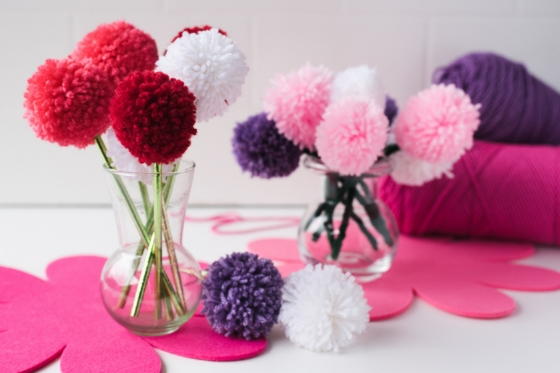
Provisional Cast-On: A method of casting on the cast-on leaves the stitches "live" so you can join the other end of the knitting to it. Often used in projects like infinity scarves.
Portuguese Knitting: A knitting style that involves holding the tension of the yarn around the neck instead of in the knitter's hands. Many knitters find that this style helps them knit faster, especially in purl-heavy patterns. - Learn More
Positive Ease: A term used in knitting fitted garments (often sweaters) that refers to either a particular gauge used or additional stitches added to make the garment looser than the exact measurements.
Purlwise (As If to Purl): Often used when talking about slipped stitches or when giving detailed instructions on a particular increase or decrease, this term refers to inserting your working needle in a way that puts the leading leg of your yarn on the left-hand side of your needle.
Q
R
Repeat: A part of a pattern that is repeated multiple times throughout a row. In written patterns, this is often indicated with these symbols: ( ), [ ], or *
Ribbing: Alternating columns of knitting and purling in stockinette and reverse stockinette formation. Ribbed stitches typically have a tighter gauge than the rest of the work due to the way yarn curls between knit and purled stitches. When used as the cuff of a sweater or the brim of a hat, this creates a nice, stretchy edge of the garment. - Learn More
Ridge: Ridges are formed in knitting when rows of purl bumps are placed in between rows of knit stitches. The forward pull of purl stitches at the top and bottom push the stitch forward, creating the ridge. - Learn More
Right Side (RS): The right side of your work is the front side of a piece of knitted fabric, opposite the wrong side, that is typically meant to be the more visible side when the fabric is complete. For example, in stockinette stitch, the right side is the side with the V sides of the stitches.
Roositud: Roositud is an Estonian inlay (or embroidery) technique that embroiders your knitting as you work the stitches. This versatile form of colorwork allows for some truly stunning patterns that are not possible to knit with traditional stranded knitting or intarsia.
Round: A term used in circular knitting patterns in place of "row." Because you will never turn your knitting in knitting in the round (except to do short rows), you will very rarely find a wrong side round.
Roving: A kind of yarn that is not completely twisted or plied during the spinning process. This kind of yarn is often used to create extra bulky projects.

Rowing Out: Rowing out is a term that is used to describe uneven tension between rows of stockinette. Common among all knitters -- beginner and experienced -- this can be avoided with a few simple tricks like changing the needle size for purled rows or even simply blocking. - Learn More
S
Seed Stitch: Seed stitch is typically the first "textured" stitch that knitters will learn. This stitch is formed by alternating a k1, p1 row with a p1, k1 row, creating a sort of checkerboard of purl bumps. - Learn More
Selvedge (Selvage): Sometimes also called a slip stitch edge or a structured edge, these techniques involve slipping and working the first and last stitches in each row in a given pattern to create a cleaner looking edge to your fabric. There are several methods of doing this but the most common is to simply slip the first stitch of each row and work the last stitch in pattern. - Learn More
Setedsal: A style of colorwork from Norway, known for intricate yokes featuring floral and snowflake patterns as well as lice fields. Setesdal sweaters often only use two colors -- white and a dark accent color.
Shaping: Shaping is a term that is typically used in patterns for garments like hats and sweaters. This refers to the frequency of decreasing and/or increasing in order to shape the garment to fit given measurements.
Shetland Knitting: If you're picturing a woman standing in the Scottish highlands with a knitting needle attached to a belt around her waist and knitting, you're probably not far off. The Shetland style of knitting goes by many names, but it's recognizable because of the way the working needle is held against the body. Because the dominant hand doesn't have to worry about holding the tension of the yarn and the working needle at the same time, this style of knitting is much faster. This is also one of only a few styles of knitting that can be done standing up. - Learn More
Short Rows: Short rows are created when the work is before reaching the end of a row, knitting back a certain number of stitches, and then continuing on as usual. This purpose of this is to increase the number of stitches vertically (instead of horizontally) in the fabric, which makes it buckle outward. These are often used in sock patterns. - Learn More
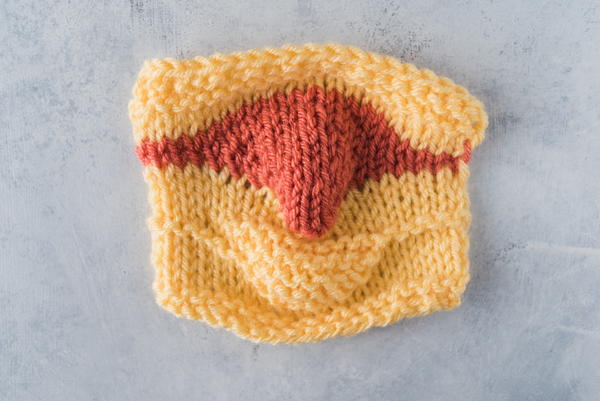
Slip Knot: Slip knots are the basis of every knitting pattern and always form the first stitch of your cast on row. - Learn More
Slip Stitch: A slip stitch is a stitch that is simply slipped from the non-dominant needle to the working needle without being worked. Unless specified otherwise, you will always slip a stitch purlwise with the yarn on the wrong side of your work.
Sport: Sport weight yarn is a common, very light weight yarn that corresponds to weight 2. Sport weight yarn is often used for lace, socks, and baby items. - Learn More
Stashbusters: Patterns that are designed to use either a small amount of yarn or small patches of a particular color of yarn in order to use up scrap yarn that's left over from bigger projects.
Steek: Steeking is using a pair of scissors to your knitting and cut up a column of stitches in order to open up your work. This is typically done with sweaters that are knit in the round in order to transform them into cardigans. - Learn More
Stitch: In knitting, a "stitch" can refer to two different things -- individual stitches that are made with the needles and stitch patterns that are formed with various combinations of individual stitches. - Learn More
Individual Stitch
There are basically two individual stitches in knitting, the knit stitch and the purl stitch. More advanced knitting techniques include variations and combinations of these two stitches, but knitting and purling are at the core of every stitch you will make with your knitting needles. Stitch patterns, on the other hand, come in hundreds of shapes, sizes, and combinations.
Stitch Pattern
Stitch patterns are made up of certain combinations of individual stitches to create an overall more complicated pattern. - Learn More
Stockinette Stitch: Typically the second stitch that knitters learn, after garter stitch, that involves knitting the right side rows and purling the wrong side rows. - Learn More
Stranded Knitting: A method of knitting colorwork wherein the color not being used is held on the wrong side of the work, creating strands or "floats" in the back.
T
Tacking: A term for catching long floats on the wrong side of your work in stranded knitting.
Thrumming: Knitting fleece or roving yarn into your work to give it more insulation/warmth. You usually see this on mittens. - Learn More
Tink: "Tink" is simply "knit" spelled backward. This method of undoing knit stitches is used when a mistake is noticed in the same row. Instead of frogging, tinking lets you work your stitches backward to find the error. - Learn More
Together: A term that indicates that a maneuver is done to multiple stitches simultaneously. You will probably come across this term in k2tog and p2tog.
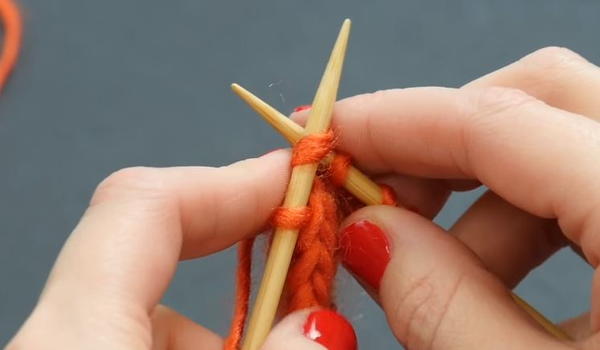
U
V
W
Wale: A column of stitches.
Western Knitting (Method): Western knitting is a method of knitting that puts the leading leg in the front of the work for knit and purl stitches and works all stitches through the front loop. For more information on this method, look for the entry on Combination knitting.
WIP(s): A common slang term among knitters that stands for "work in progress."
Work Even: A term often used in knitting garments that require shaping. This simply means that you will continue in the pattern designated (for example stockinette stitch) without any increasing or decreasing.
Worsted: Worsted weight yarn is one of the most popular weight of yarn for knitters. This weight of yarn is typically categorized as a weight 4 yarn, and it's great for things like scarves, afghans, and sweaters. - Learn More
Wrong Side (WS): The wrong side of your work is the back side of a piece of knitted fabric, opposite the right side, that is typically meant to be the less visible side when the fabric is complete. For example, in stockinette stitch, the right side is the side with the purl bumps of the stitches.
X, Y, Z
Yarn Bombing: Yarn bombing is a form of yarn-based street art where knitters and crocheters cover trees, poles, and public structures with knitted and crocheted fabric. You've most likely seen yarn bombing on trees, bicycle racks, and statues, but there have been popular "yarnstallations" that cover vehicles, benches, and even entire buildings. - Learn More
Yarn Over: A method of increasing stitches in your work that creates a small eyelet in the fabric. Often used in lace knitting. - Learn More
Zero Ease: As with positive and negative ease, zero ease refers to the intended or unintended fit of a particular garment. While negative ease indicates that a garment is smaller than the measurements and positive ease indicates a larger, baggier fit, zero ease means that the garment itself matches the measurements exactly.
What terms did we leave out?
Let us know in the comments!
Read NextYarn Weight Categories 101
Your Recently Viewed Projects
Report Inappropriate Comment
Are you sure you would like to report this comment? It will be flagged for our moderators to take action.
Thank you for taking the time to improve the content on our site.

